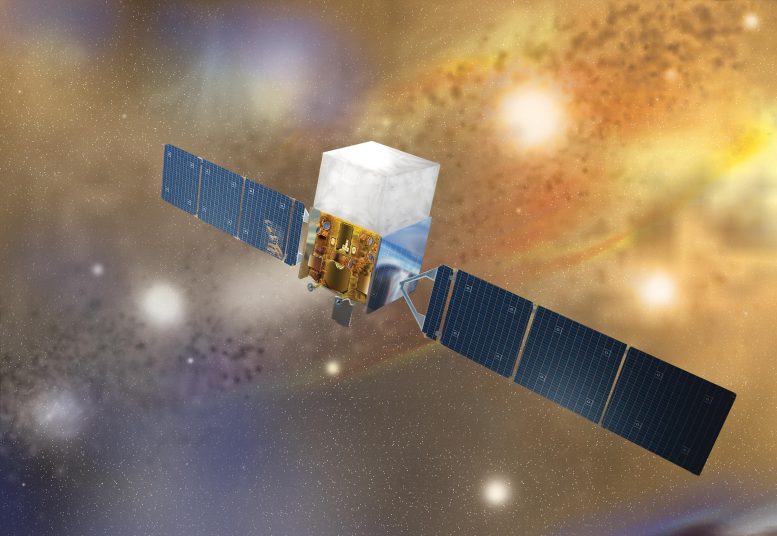
NASA’s Fermi Gamma-ray Space Telescope has created a stunning all-sky time-lapse movie from 14 years of data, capturing the dynamic universe. It highlights the Sun’s path, the gamma-ray glow of the Milky Way, and distant galaxies known as blazars. The movie reveals both the beauty and complexity of the cosmos, showcasing high-energy events from across the galaxy and beyond, including eruptions from supermassive black holes. (Artist’s concept.) Credit: SciTechDaily.com
NASA’s Fermi Space Telescope presents a 14-year time-lapse movie, revealing the dynamic universe through gamma-ray imaging. It highlights the Milky Way’s gamma-ray glow, solar flares, and distant galaxies powered by black holes.
The cosmos comes alive in an all-sky time-lapse movie made from 14 years of data acquired by NASA’s Fermi Gamma-ray Space Telescope. Our Sun, occasionally flaring into prominence, serenely traces a path through the sky against the backdrop of high-energy sources within our galaxy and beyond.
“The bright, steady gamma-ray glow of the Milky Way is punctuated by intense, days-long flares of near-light-speed jets powered by supermassive black holes in the cores of distant galaxies,” said Seth Digel, a senior staff scientist at SLAC National Accelerator Laboratory in Menlo Park, California, who created the images. “These dramatic eruptions, which can appear anywhere in the sky, occurred millions to billions of years ago, and their light is just reaching Fermi as we watch.”
From solar flares to black hole jets: NASA’s Fermi Gamma-ray Space Telescope team has produced a unique time-lapse tour of the dynamic high-energy sky. Fermi Deputy Project Scientist Judy Racusin narrates the movie, which compresses 14 years of gamma-ray observations into 6 minutes. Credit: NASA’s Goddard Space Flight Center and NASA/DOE/LAT Collaboration
Gamma rays are the highest-energy form of light. The movie shows the intensity of gamma rays with energies above 200 million electron volts detected by Fermi’s Large Area Telescope (LAT) between August 2008 and August 2022. For comparison, visible light has energies between 2 and 3 electron volts. Brighter colors mark the locations of more intense gamma-ray sources.
“One of the first things to strike your eye in the movie is a source that steadily arcs across the screen. That’s our Sun, whose apparent movement reflects Earth’s yearly orbital motion around it,” said Fermi Deputy Project Scientist Judy Racusin, who narrates a tour of the movie, at NASA’s Goddard Space Flight Center in Greenbelt, Maryland.
Most of the time, the LAT detects the Sun faintly due to the impact of accelerated particles called cosmic rays – atomic nuclei traveling close to the speed of light. When they strike the Sun’s gas or even the light it emits, gamma rays result. At times, though, the Sun suddenly brightens with powerful eruptions called solar flares, which can briefly make our star one of the sky’s brightest gamma-ray sources.
The movie shows the sky in two different views. The rectangular view shows the entire sky with the center of our galaxy in the middle. This highlights the central plane of the Milky Way, which glows in gamma rays produced from cosmic rays striking interstellar gas and starlight. It’s also flecked with many other sources, including neutron stars and supernova remnants. Above and below this central band, we’re looking out of our galaxy and into the wider universe, peppered with bright, rapidly changing sources.
Most of these are actually distant galaxies, and they’re better seen in a different view centered on our galaxy’s north and south poles. Each of these galaxies, called blazars, hosts a central black hole with a mass of a million or more Suns.
Somehow, the black holes produce extremely fast-moving jets of matter, and with blazars we’re looking almost directly down one of these jets, a view that enhances their brightness and variability. “The variations tell us that something about these jets has changed,” Racusin said. “We routinely watch these sources and alert other telescopes, in space and on the ground, when something interesting is going on. We have to be quick to catch these flares before they fade away, and the more observations we can collect, the better we’ll be able to understand these events.”
Fermi plays a key role in the growing network of missions working together to capture these changes in the universe as they unfold.
Many of these galaxies are extremely far away. For example, the light from a blazar known as 4C +21.35 has been traveling for 4.6 billion years, which means that a flare-up we see today actually occurred as our Sun and solar system were beginning to form. Other bright blazars are more than twice as distant, and together provide striking snapshots of black hole activity throughout cosmic time.
Not seen in the time-lapse are many short-duration events that Fermi studies, such as gamma-ray bursts, the most powerful cosmic explosions. This is a result of processing data across several days to sharpen the images.
The Fermi Gamma-ray Space Telescope is an astrophysics and particle physics partnership managed by Goddard. Fermi was developed in collaboration with the U.S. Department of Energy, with important contributions from academic institutions and partners in France, Germany, Italy, Japan, Sweden, and the United States.










Very. Nice information technology information 🛸🛸🛸🛸✨✨✨✨✨✨✨💫💫💫💫💫💫💫💫💫💫💫🌟🌟🌟🌟🌟🌟🌟⭐⭐⭐⭐⭐❤️❤️❤️❤️❤️
Better than the latest Marvel output.
2018 had bits missing yeah we swapped to a different Alternate universe 😬
This is so good information ❤️❤️❤️❤️❤️❤️❤️❤️❤️❤️❤️
What
This is so good information ❤️❤️❤️❤️❤️❤️❤️❤️❤️❤️❤️ Ty
What
What in the world is that object travelling from mid right dipping through the galaxy(?) and continuing to travel down into the bottom of the left side of the video?
The narrator says it is the sun.
Interesting…
Interesting… Very interesting…
The Fermi GST is a “photon” counter.
How many photons has it counted, so far, or, for example, per year? I bet these are very large numbers — numbers it would fun (and informative) to see, down to the exact count.
Why don’t we build a spaceport on the moon?
We could combine the tech from each country and construct a place in the moon to build ships for space (less gravity to deal with for launchings).